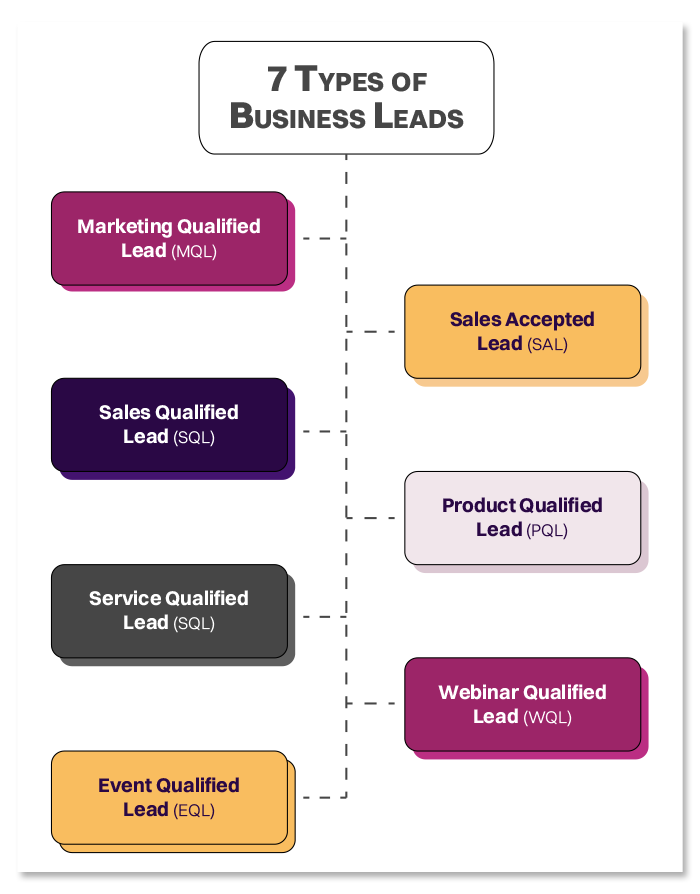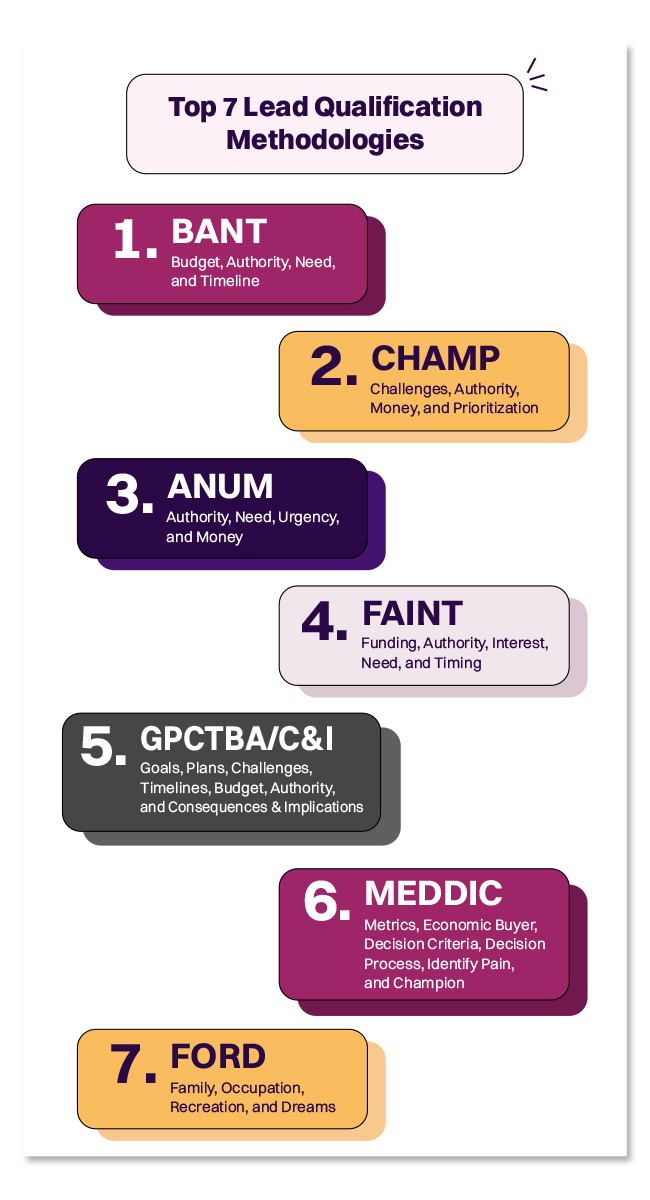
Lead Qualification Methods: 7 Methodology for Sales Success
Are you looking to improve your sales and marketing strategies? One crucial factor to consider is lead qualification methods. But what exactly is the lead qualification, and how does it differ from lead generation?
Simply put, lead qualification evaluates potential customers to determine their likelihood of becoming paying customers. It involves identifying and assessing leads based on their:
- Level of interest
- Budget
- Authority
- Need for your product or service
Lead generation focuses on increasing the number of leads. On the contrary, lead qualification focuses on improving lead quality.
In this article, we'll dive into the seven main types of lead qualification methods that we use as a demand gen agency.
However, first, let’s understand some of the basics.
First, check the types of leads before jumping into lead qualification methods.
7 Types of Business Leads
 To clearly comprehend how lead qualification works, you also MUST better understand the types of business leads. So, here are the top seven categories:
To clearly comprehend how lead qualification works, you also MUST better understand the types of business leads. So, here are the top seven categories:
- Marketing Qualified Lead (MQL): An MQL lead that has shown interest in your product or service through marketing efforts, such as downloading a whitepaper or attending a webinar.
- Sales Accepted Lead (SAL): A lead that has been accepted by your sales team as a potential customer – based on their level of interest and fit with your product or service.
- Sales Qualified Lead (SQL): A lead that has been determined by your SDRs to be a good fit for your product or service and is actively engaged in the sales process.
- Product Qualified Lead (PQL): A lead that has shown interest in your product or service by actually using or testing it out, such as through a free trial or demo.
- Service Qualified Lead (SQL): A lead that has demonstrated interest in your offering by requesting a consultation or appointment with your team.
- Webinar Qualified Lead (WQL): A lead that has attended a webinar and expressed interest in your product or service through engagement during the event or post-event follow-up.
- Event Qualified Lead (EQL): A lead generated from a specific event, such as a trade show or conference and has shown interest in your product or service through their attendance or engagement.
How Lead Qualification Works?
Lead qualification works by evaluating potential customers based on various criteria to determine their likelihood of becoming paying customers.
This process typically involves a set of qualifying questions posed through:
- A phone call
- An email
- An online form
These qualifying questions help identify critical factors of potential customers mentioned below:
- Level of interest
- Budget
- Decision-making authority
- Need for the product or service being offered
For example: Let's say a lead fills out a form on your website requesting your software demo, providing information that helps you gauge their interest. You can then follow up with an email or phone call to ask additional qualifying questions about their budget and decision-making authority to determine whether they are a qualified lead for your sales development team.
Why Lead Qualification is Crucial
Here are the top three reasons why lead qualification is so important:
- Maximizes sales efforts: Lead qualification ensures your SDRs (Sales Development Representatives) focus on the most promising leads. As such, it increases the chances of closing a sale and improves overall sales productivity.
- Improves customer experience: By identifying the needs of potential customers, lead qualification allows your sales development team to provide more personalized solutions. Hence, it improves the customer experience and builds trust in your brand.
- Saves time and resources: By focusing your sales efforts on qualified leads, you save time and resources on unqualified leads. Hence, it frees your team to pursue more promising opportunities.
Top 7 Lead Qualification Methods
 Now that you have a good idea about lead qualification, let’s explore its major frameworks.
Now that you have a good idea about lead qualification, let’s explore its major frameworks.
However, note that each of our below-mentioned lead qualification methodologies has its strengths and weaknesses.
Therefore, you may use one or a combination of several to identify and prioritize your leads effectively.
So, here we go!
- BANT
- CHAMP.
- ANUM
- FAINT
- GPCTBA/C&I
- MEDDIC
- FORD
1. BANT
BANT stands for Budget, Authority, Need, and Timeline. This sales qualification methodology evaluates a lead's:
- Budget,
- Decision-making authority,
- Need for the product or service,
- Timeline for purchase
– to determine whether they are a high-quality lead that is worth pursuing.
Here's an example of how BANT might work in practice:
Let's say your software company’s SDR attempt to sell a project management tool. You receive a lead from a company interested in your product. Using the BANT methodology, you would:
- Budget: Ask the lead about their budget for purchasing a project management tool.
- Authority: Enquire who would be making the final decision about purchasing the tool.
- Need: Request details about their specific project management need and how your product can meet them.
- Timeline: Finally, ask the lead about their timeline for purchasing a project management tool.
BANT can be useful for B2B sales, especially when dealing with larger organizations. Here are a few examples of organizations that might benefit from using the BANT methodology:
- Enterprise software companies
- Marketing agencies
- Consulting firms
2. CHAMP
CHAMP means – Challenges, Authority, Money, and Prioritization. This sales qualification methodology helps you evaluate leads based on their:
- Business challenges
- Decision-making authority
- Budget
- Level of prioritization for solving those challenges
Here's an example of how CHAMP might work in practice:
Let's say you are an SDR for a cybersecurity company that sells solutions to protect against data breaches. You receive a lead from a company interested in your product. Using the CHAMP methodology, you would pose the following queries:
- Challenges: What are their cybersecurity issues and what kind of data issues would they face?
- Authority: Who will be making the final decision about purchasing a cybersecurity solution?
- Money: What is their budget for investing in cybersecurity?
- Prioritization: What is their level of prioritization for solving cybersecurity issues?
Companies that market solutions to address specific business difficulties may find CHAMP valuable. It is useful for B2B sales, especially when dealing with complex solutions or services. For instance:
- IT service providers
- Management consulting firms
3. ANUM
ANUM refers to Authority, Need, Urgency, and Money. This methodology helps you evaluate leads based on their:
- Decision-making authority
- Need for the product or service
- The urgency to solve the problem
- Budget
Here's an example of how ANUM might work in practice:
Let's say you are an SDR for a software company that sells a productivity tool. You receive a lead from a company interested in your product. Using the ANUM methodology, you would ask the lead the following questions:
- Authority: Who would be making the final decision about purchasing a productivity tool?
- Need: What are their specific productivity challenges and how your tool could help solve them?
- Urgency: What is the timeline for implementing a productivity tool and whether any urgent needs need to be addressed quickly?
- Money: What is their budget for investing in a productivity tool?
Businesses that might find ANUM useful are those that sell solutions to help firms with their productivity or efficiency. This includes determining if a lead has decision-making authority and a clear need for the product or service being offered. For example:
- Technology companies
- Management consulting firms
4. FAINT
FAINT stands for Funding, Authority, Interest, Need, and Timing. This lead qualification methodology helps you evaluate the quality of a lead based on their:
- Level of funding
- Decision-making authority
- Interest
- Need for the product or service
- Timing
Here's an example of how FAINT might work in practice:
Let's say you work for a marketing agency specializing in social media advertising. You receive a lead from a company interested in your services. Using the FAINT methodology, you can request the following details:
- Funding: What is their budget for social media advertising and do they have the necessary funding to invest in your services?
- Authority: Who will be making the final decision about social media advertising?
- Interest: What is their level of interest in your services and are they actively seeking a solution?
- Need: What are their specific social media advertising challenges and how could your services help solve those challenges?
- Timing: What is their timeline for implementing social media advertising and are there are any urgent actions that need to be addressed quickly?
Businesses that find FAINT useful offer services or products that require a significant investment from the customer, such as technology solutions or consulting services. For example:
- Software companies
- Consulting firms
5. GPCTBA/C&I
GPCTBA/C&I is a lead qualification methodology that means Goals, Plans, Challenges, Timelines, Budget, Authority, and Consequences & Implications.
This methodology helps businesses evaluate the quality of a lead by assessing their:
- Goals
- Plans
- Challenges
- Timelines
- Budget
- Decision-making authority
- Consequences and implications of their decision
Here's an example of how GPCTBA/C&I might work in practice:
Let's say you work for a sales consulting firm and receive a lead from a company interested in your services. Using the GPCTBA/C&I methodology, you would ask the following questions:
- Goals: What are their sales goals and objectives and how do they align with your consulting services?
- Plans: What are their sales plans and strategies and how could your consulting services help them achieve their goals?
- Challenges: What are their sales challenges and pain points and how could your consulting services help address those challenges?
- Timeline: What is their timeline for implementing social media advertising and do they have any urgent needs that need to be addressed quickly?
- Budget: What is their budget for sales consulting services and do they have the necessary funding to invest in your services?
- Authority: Who will be making the final decision about sales consulting services?
- Consequences & Implications: What are the potential consequences and implications of not addressing their sales challenges? How could your consulting services help mitigate those risks?
Businesses that might find GPCTBA/C&I useful are those that offer consulting services, especially in sales, marketing, and business strategy. For example:
- Sales consulting firms
- Marketing agencies
6. MEDDIC
MEDDIC refers to Metrics, Economic Buyer, Decision Criteria, Decision Process, Identify Pain, and Champion. This methodology helps businesses evaluate the quality of a lead by assessing the potential buyer's:
- Decision-making process
- Pain points
- The economic viability of the sale
Here's an example of how MEDDIC might work in practice:
Let's say you work for a software company that sells marketing automation software. Using the MEDDIC methodology, you would request the following information:
- Metrics: What are the potential buyer’s marketing automation goals and the key performance indicators (KPIs) they use to measure success? This would enable you to determine whether your software can help them achieve their goals.
- Economic Buyer: Who is the potential buyer’s economic buyer within their organization with the authority to sign off on the purchase? This would help you understand who you need to influence during the sales process.
- Decision Criteria: What are the potential buyer’s decision-making criteria, including any must-haves or deal-breakers? This would allow you to tailor your pitch to address their specific needs.
- Decision Process: What is the potential buyer's decision-making process and who is involved in making the final decision? This would aid you in understanding the decision-making hierarchy and who you need to engage during the sales process.
- Identify Pain Points: What are the potential buyer’s pain points and challenges, and what's driving them to consider marketing automation software? This would help you identify areas where your software can address their needs and pain points.
- Champion: Does the potential buyer have someone within their organization who is particularly interested in your software and can champion your product to other decision-makers? This would guide you in identifying potential allies within the organization who can help you influence the decision-making process.
Businesses that might find MEDDIC useful are those that offer software, technology, or B2B solutions that require significant investment and involve complex decision-making processes. For example:
- Technology companies
- Consulting firms
7. FORD
FORD is a lead qualification methodology that stands for Family, Occupation, Recreation, and Dreams. This methodology helps businesses build rapport with potential buyers by:
- Identifying areas of common interest
And - Establishing a personal connection
By doing so, you can establish a sense of trust and make it easier to move the conversation toward a potential sale.
Here's an example of how FORD might work in practice:
Let's say you work for a financial advisory firm. Using the FORD methodology, you would ask the following questions:
- Family: What is the potential buyer's family situation? Do they have children or are they married? This would help you establish a personal connection and build rapport.
- Occupation: What is the potential buyer’s occupation and what do they do for a living? This would enable you to understand their financial needs and goals.
- Recreation: What is the potential buyer’s hobbies and interests outside of work? This would aid you in identifying areas of common interest and establishing a personal connection.
- Dreams: What are the potential buyer’s long-term financial goals and aspirations? This would help you understand their financial needs and tailor your advice to their goals.
Businesses that might find FORD useful offer services or products that involve establishing a personal connection with potential buyers. For example:
- Financial advisors
- Real estate agents
Lead Qualification Checklist
Digging more into the importance of lead qualification, here is your go-to checklist:
1. Identify the key attributes of your ICP
- Industry or market segment
- Company size or revenue
- Geographic location
- Job title or role
2. Develop qualifying questions
- What are your pain points or challenges?
- What are your goals or objectives?
- What is your budget for the product or service?
- What is your timeline for making a purchase decision?
- Who is involved in the decision-making process?
3. Establish a lead scoring system
- Assign a point value to each qualifying question
- Determine the minimum score required for a lead to be considered qualified
- Prioritize leads with higher scores for follow-up by the sales team
4. Regularly review and adjust your lead qualification criteria
- Analyze the effectiveness of your qualifying questions and lead scoring system.
- Adjust your criteria and questions as needed to improve lead quality and increase conversion rates.
When to Disqualify Prospects
One of the key aspects of lead qualification is knowing when to disqualify a prospect. There are a few common reasons why you might want to disqualify a lead, such as:
- The prospect doesn't meet your ideal customer profile: For example, if your product or service is designed for small businesses, a lead from a large enterprise may not be a good fit.
- The prospect isn't interested in your product or service: This could be due to a number of factors, such as a lack of need or a preference for a competitor's offering.
- The prospect doesn't have the budget or authority to make a purchase: If a prospect isn't able to make the purchasing decisions or doesn't have the resources to buy your product or service, it may not be worth pursuing the opportunity.
Here is an example of when to disqualify a prospect:
Let's say your marketing agency specializes in social media advertising. You receive a lead from a company that sells high-end luxury goods. However, their target audience is primarily seniors who may not be active on social media.
In this case, it may be best to disqualify the prospect early to avoid wasting time and resources on an unlikely opportunity.
The Top 5 Benefits of Lead Qualification
To better understand why you MUST always qualify your leads before pursuing them, here are the top 5 benefits of lead qualification:
- Saves time and resources: By identifying and prioritizing high-quality leads, you can save valuable time and resources on leads likely to convert.
- Improves conversion rates: By focusing on leads most likely to make a purchase, you can increase their conversion rates and generate more revenue.
- Enhances customer satisfaction: You can build stronger relationships and improve customer satisfaction by providing personalized experiences tailored to each lead's needs and interests.
- Streamlines the sales process: By providing SDRs with relevant information about each lead, you can streamline the sales process and improve efficiency.
- Builds a strong pipeline of potential customers: By qualifying leads effectively, you can build a strong pipeline of potential customers for future sales opportunities.
Lead Qualification Questions
As you have already seen in all the above methods, a critical factor to consider is the types of questions you’ll ask when qualifying a lead. These queries are designed to help you evaluate potential buyers. They also enable you to determine whether they are a good fit for your products or services.
Here are the top four most common lead qualification questions that may be used across different types of lead qualification frameworks:
- What is your budget for this product or service? This question helps you determine whether the potential buyer has the financial means to purchase your product or service.
- What is your timeline for purchasing this product or service? This query enables you to determine the urgency of the potential buyer's needs and whether they are a high-priority lead.
- What is your current pain point or problem that you're trying to solve? This question allows you to understand the potential buyer's needs and determine whether your product or service can provide a solution.
- What is your role in the decision-making process? This query helps you gauge the potential buyer's decision-making power and identify any other decision-makers involved in the purchasing process.
The Top 5 Steps to Enhance Lead Qualification Methods
As it’s clear by now, lead qualification is an important aspect of any successful sales and marketing strategy. So, let’s check out five steps to enhance your lead qualification process:
- Develop a clear ideal customer profile: Understand the characteristics of your ideal customer. Then, you can focus your lead qualification efforts on prospects most likely to become long-term customers.
- Utilize scoring models to prioritize leads: Scoring models allow you to assign a value to each lead based on their level of engagement and fit with your product or service. As such, it helps you prioritize your efforts and focus on high-potential leads.
- Use automation to streamline the process: Automation tools can help you automatically score and prioritize leads based on their engagement and fit. Therefore, it reduces the amount of manual effort required.
- Ensure alignment between sales and marketing: This includes establishing a shared definition of a qualified lead. Plus, it also involves regular communication and feedback loops – to ensure the process works effectively.
- Continuously evaluate and refine your process: Lead qualification is not a one-time event. So, regularly assess your strategy and adjust as needed. As a result, you can ensure you are maximizing your sales and marketing efforts.
Finally, Lead Qualification With CRM
A CRM (Customer Relationship Management) system allows you to track leads throughout the entire sales funnel – from initial contact to final conversion. Hence, it is easier to identify high-quality leads and prioritize your efforts accordingly.
Here are the top two ways you can use a CRM system for lead qualification:
- Lead scoring: A CRM system can assign a score to each lead based on specific criteria, such as – their level of engagement, budget, and pain points.
- Lead nurturing: CRMs create customized campaigns and content to nurture leads throughout the sales funnel.
Conclusion
Lead qualification is a critical process that can significantly improve a business's closing rate. This can:
- Save time and resources
- Increase the efficiency of the sales process
- Lead to more successful conversions and revenue growth
Revnew’s expertise in B2B outbound sales development, marketing, and revenue growth can help you identify the best lead qualification methodology for your needs and implement it effectively.


.jpg?width=352&name=sales-lead-qualification-frameworks-meddicvs-bant-vs-champ).jpg)

